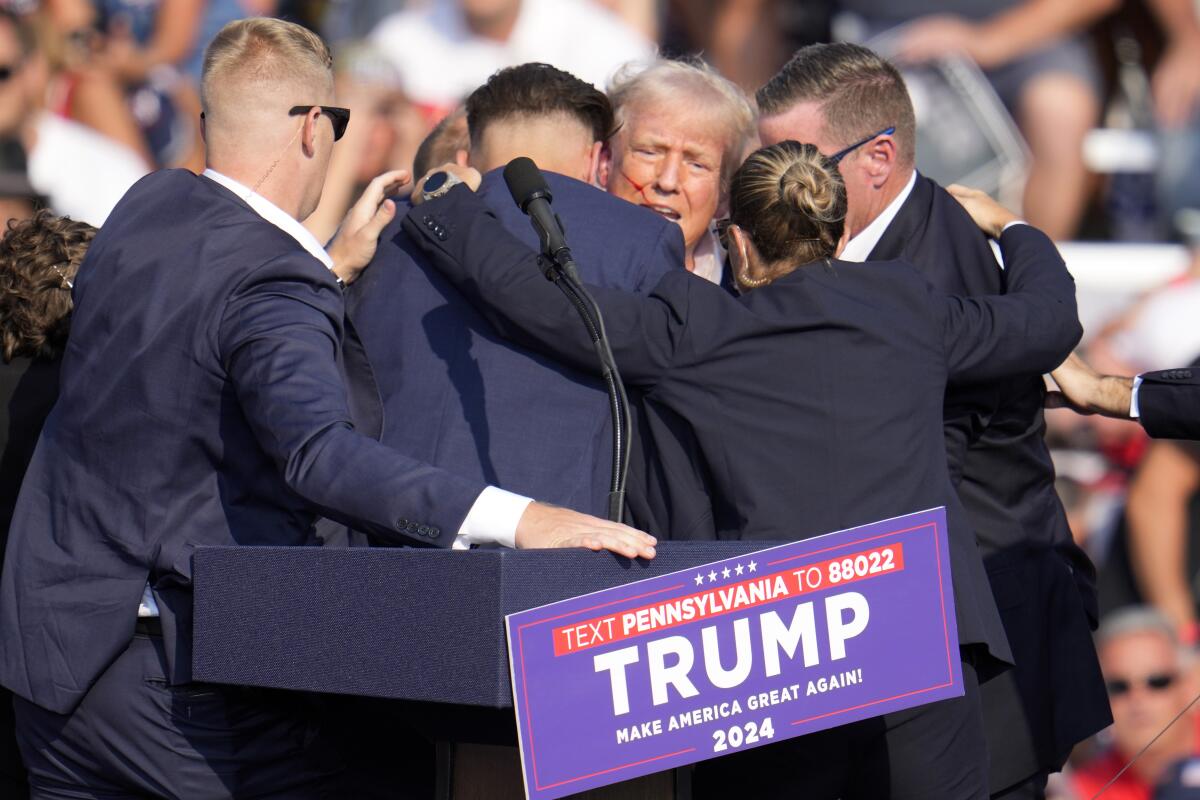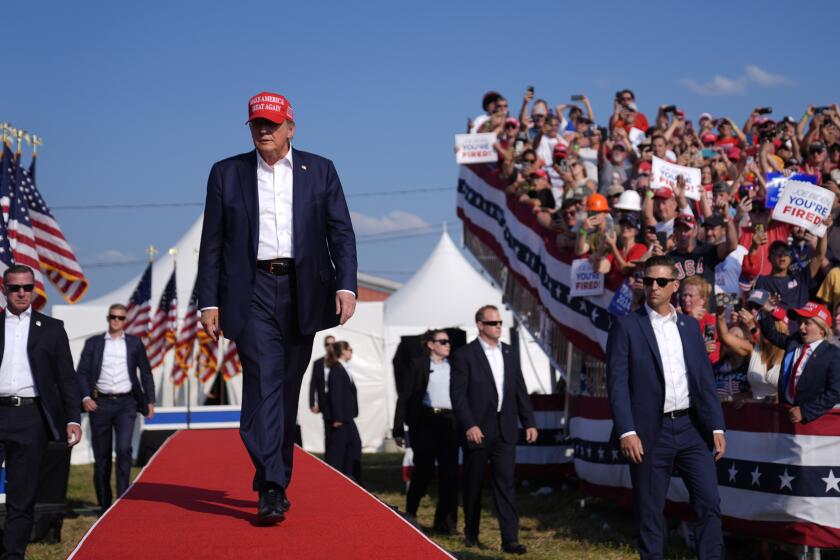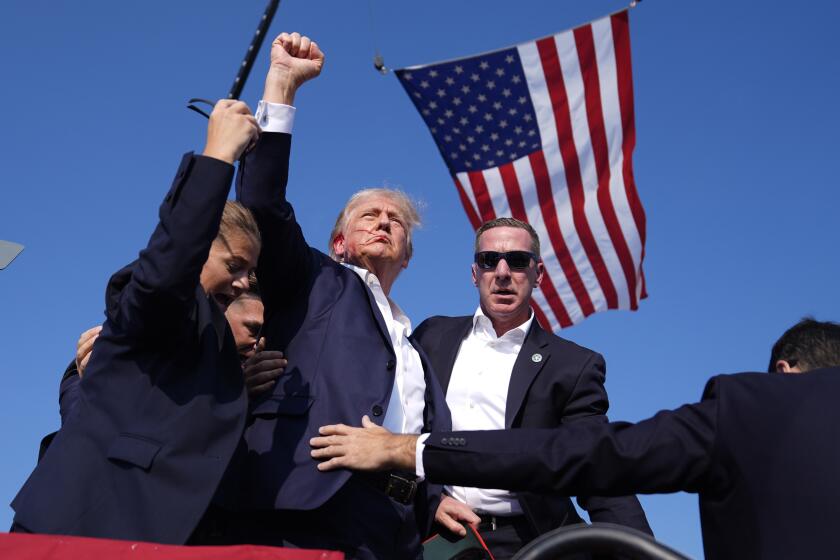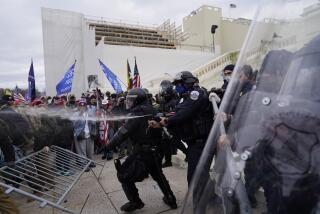After Trump is shot, conspiracy theories flood the internet, creating dangerous ‘spiral’

- Share via
The attempted assassination of former President Trump at a rally Saturday in Pennsylvania almost immediately gave rise to internet conspiracy theories that experts say will influence how the nation deals with the shocking act of political violence.
The Trump attack marks the first time in decades someone had tried to take a presidential candidate’s life. While previous assassinations — notably the killing of President John F. Kennedy in 1963 — have brought conspiracy theories, the rise of partisan social media allows such claims to spread rapidly and in unexpected ways.
The Trump shooting claims typically came from random social media users — the writers casting aspersions or seeking to affix blame based on their place in the nation’s intensely polarized political landscape.
The conspiracies formed two now familiar camps — one blaming the “deep state” for what happened, the other claiming without evidence that the shooting was not what it seemed.
“Seemed staged,” one social media user wrote.
But even some elected officials joined with false claims. “Joe Biden sent the orders,” Rep. Mike Collins (R-Ga.) wrote on X, the social media platform.
The attempted assassination of former President Trump — and how close it came to being successful — stunned operatives of both parties familiar with the precision and detail taken by the Secret Service.
Some claim their own detective work exposed the conspiracy theories.
“What’s always interesting to me about moments like this is that digital sleuths, be they everyday people, be they politically motivated online trolls … we’re all looking in the same place for reliable true and correct information,” said Joan Donovan, a professor of journalism and emerging media studies at Boston University and founder of the Critical Internet Studies Institute. “What’s hard, I think, for the everyday person, is what they’re really looking for is verified information that they can use.”
The current media ecosystem has primed users to feed off rapid, often unverified information, said Michael Spikes, a journalism professor at Northwestern University. And as news outlets shutter across the country, there are fewer sources to vet breaking news events.
As a result, people turn to social media platforms immediately as a news event is breaking. Almost half of all TikTok users say they get their news from the app, according to the Pew Research Center. Occasionally, items that seem unverified at first later become substantiated — such as a video circulating on the internet message board 4chan that was later confirmed to identify the shooter, Donovan said.
But the purpose of information served up on social media is not always to inform as much as to incite reactions, Spikes said.
“When you have that overload of information, your own reasoning ability sort of shuts down because your brain just goes, this is too much,” he said. “An individual person cannot go through hundreds and hundreds of videos of what has happened, and ... make sense out of that. All we can do is react to what we have seen.”
“We’re evolutionarily programmed to search for information when we’re fearful ... to basically understand the nature of the threat,” said Erik Nisbet, professor of policy analysis and communication at Northwestern University. “And this is where conspiracy theories like this will take advantage of that sort of emotional reaction.”
By Saturday night, a couple of concerted theories emerged. In one voiced by several prominent conservatives, the belief that Trump is a threat to democracy, often lobbed by the left, in effect placed a target on his back.
“Today is not just some isolated incident,” Sen. J.D. Vance (R-Ohio), whom Trump named as his running mate Monday, posted on X. “The central premise of the Biden campaign is that President Donald Trump is an authoritarian fascist who must be stopped at all costs. That rhetoric led directly to President Trump’s attempted assassination.”
Other social media users pointed to a statement President Biden made last week, when attempting to assuage the swirl of media attention around his debate performance, saying, “It’s time to put Trump in a bull’s-eye.” Others falsely alleged that security for Trump was cut back.
“Theres an untrue assertion that a member of the former president’s team requested additional security resources & that those were rebuffed. This is absolutely false,” Anthony Guglielmi, chief of communications for the U.S. Secret Service, wrote on X. “In fact, we added protective resources & technology & capabilities as part of the increased campaign travel tempo.”
The image of former President Trump’s gesture at his rally in Pennsylvania, after escaping an assassination attempt, is likely to fuel the rest of his campaign.
Political leaders tried to quell the rising tide of conspiracy theories — even as others among their ranks whipped up the fervor.
“This morning, ascend above the hate, the vitriol, and the simple-minded ideas that ignite violence. We all want a world where respect is paramount, family is first, and love transcends,” former First Lady Melania Trump said in a statement. “We can realize this world again. Each of us must demand to get it back. We must insist that respect fills the cornerstone of our relationships, again.”
Meanwhile, the former president’s son Donald Trump Jr. opted for a more impassioned post on X: “Dems and their friends in the media knew exactly what they were doing with the ‘literally Hitler’ bull—!”
The hot takes on the internet create a ripe breeding ground for increased division and potential violence, Nisbet said.
“We see each other as enemies, not as fellow Americans,” Nisbet said. “If the other side is immoral, not human, is an existential threat to us and to our country, then it is morally OK to take violent action against them.”
One of the main drivers of political violence is perception — how violent each side thinks the other is, Nisbet said.
“[It] becomes this reinforcing spiral,” Nisbet said. “That I think the other side is more violent, I engage in violence, and then the other side thinks I’m violent. And this is really dangerous for our democracy.”
More to Read
Get the L.A. Times Politics newsletter
Deeply reported insights into legislation, politics and policy from Sacramento, Washington and beyond. In your inbox three times per week.
You may occasionally receive promotional content from the Los Angeles Times.













